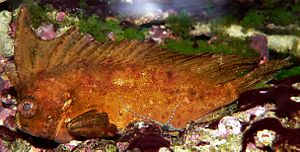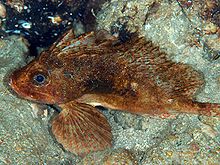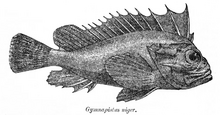Forehead fins
| Forehead fins | ||||||||||||
|---|---|---|---|---|---|---|---|---|---|---|---|---|

|
||||||||||||
| Systematics | ||||||||||||
|
||||||||||||
| Scientific name | ||||||||||||
| Tetrarogidae | ||||||||||||
| Smith , 1949 |
The forehead fins (Tetrarogidae ( Gr .: "Tetra" = four, "rogos" = wrinkled)) are a family of 17 genera and over 40 species from the order of the perch-like (Perciformes). They live in the Indian Ocean and the western Pacific . Tropical species live mainly in shallow water, species from temperate areas of South Africa , Australia and Asia are more common in deep regions below 200 meters. Two species, Notesthes robusta and Neovespicula depressifrons, live mostly in the brackish water of the estuaries in the Philippines , Indonesia , New Guinea and Australia and also penetrate the fresh water of rivers.
features
Forehead fins are 4 to 80 cm long and have moderately elongated, laterally strongly flattened bodies. A characteristic feature of the family is the dorsal fin , which begins directly above the eyes. The head is prickly and wrinkled, the gill cover usually has two spines. The gill membranes are separated from the isthmus . Forehead fins can "walk" on their well-developed pectoral fins . They usually stay on the ground and let their flattened bodies rock back and forth on the waves. They resemble a leaf (leaf mimicry ), are well camouflaged and the predatory fish do not see potential prey . Their scales are tiny, thorn-like, and lie deep in the skin. The animals have not yet been explored much. Like the scorpion fish , the forehead fins have poisonous fin rays .
Genera and species
-
Ablabys Kaup, 1873
- Ablabys binotatus (Peters, 1855)
- Ablabys gymnothorax Chungthanawong & Motomura, 2018
- Barbed waspfish ( Ablabys macracanthus (Bleeker, 1852) )
- Ablabys pauciporus Chungthanawong & Motomura, 2018
- Rocking forehead finfish ( Ablabys taenianotus (Cuvier, 1829) )
-
Centropogon Günther, 1860
- Centropogon australis (White, 1790)
- Centropogon latifrons Mees, 1962
- Centropogon marmoratus Günther, 1862
-
Coccotropsis Barnard, 1927
- Coccotropsis gymnoderma (Gilchrist, 1906)
-
Cottapistus Bleeker, 1876
- Cottapistus cottoides (Linnaeus, 1758)
-
Glyptauchen Günther, 1860
- Glyptauchen panduratus (Richardson, 1850)
-
Gymnapistes Swainson 1839
- Gymnapistes marmoratus (Cuvier, 1829)
-
Liocranium Ogilby, 1903
- Liocranium pleurostigma (Weber, 1913)
- Liocranium praepositum Ogilby, 1903
-
Neocentropogon Matsubara, 1943
- Neocentropogon aeglefinus (Weber, 1913)
- Neocentropogon affinis (Lloyd, 1909)
- Neocentropogon japonicus Matsubara, 1943
- Neocentropogon mesedai Klausewitz, 1985
- Neocentropogon profundus (Smith, 1958)
- Neocentropogon trimaculatus Chan, 1966
-
Neovespicula Mandrytsa, 2001
- Neovespicula depressifrons (Richardson, 1848)
-
Notesthes Ogilby, 1903
- Notesthes robusta (Günther, 1860)
-
Ocosia Jordan & Starks, 1904
- Ocosia apia Poss & Eschmeyer, 1975
- Ocosia fasciata Matsubara, 1943
- Ocosia possi Mandrytsa & Usachev, 1990
- Ocosia ramaraoi Poss & Eschmeyer, 1975
- Ocosia sphex Fricke, 2017
- Ocosia spinosa Chen, 1981
- Ocosia vespa Jordan & Starks, 1904
- Ocosia zaspilota Poss & Eschmeyer, 1975
-
Paracentropogon Bleeker, 1876
- Long-spiked forehead fin ( Paracentropogon longispinis (Cuvier in Cuvier & Valenciennes, 1829) )
- Paracentropogon rubripinnis (Temminck & Schlegel, 1843)
- Paracentropogon vespa Ogilby, 1910
- Paracentropogon zonatus (Weber, 1913)
-
Pseudovespicula Mandrytsa, 2001
- Pseudovespicula dracaena (Cuvier, 1829)
-
Richardsonichthys Smith, 1958
- Richardsonichthys leucogaster (Richardson, 1848)
-
Snyderina Jordan & Starks, 1901
- Snyderina guentheri (Boulenger, 1889)
- Snyderina yamanokami Jordan & Starks, 1901
-
Tetraroge Günther, 1860
- Tetraroge barbata (Cuvier in Cuvier & Valenciennes, 1829)
- Tetraroge niger (Cuvier in Cuvier & Valenciennes, 1829)
-
Vespicula Jordan & Richardson, 1910
- Vespicula cypho (Fowler, 1938)
- Vespicula trachinoides (Cuvier in Cuvier & Valenciennes, 1829)
- Vespicula Zollingeri (Bleeker, 1848)
Systematics
The forehead fins are closely related to the stone fish (Synanceiidae), but may not be monophyletic . A feature that they share with the stonefish is the tear- saber, a saber-shaped, defensive outgrowth of the lacrimale . Smith, Everman and Richardson therefore propose to assign the genera and species of the forehead fins to the stonefish.
literature
- Joseph S. Nelson : Fishes of the World , John Wiley & Sons, 2006, ISBN 0-471-25031-7 .
- Bergbauer, Myers, Kirschner: The cosmos handbook dangerous marine animals. ISBN 978-3-440-10945-8 .
Individual evidence
- ↑ Notesthes robusta on Fishbase.org (English)
- ↑ Neovespicula depressifrons on Fishbase.org (English)
- ↑ Smith, WL, Everman, E. & Richardson, C. (2018): Phylogeny and Taxonomy of Flatheads, Scorpionfishes, Sea Robins, and Stonefishes (Percomorpha: Scorpaeniformes) and the Evolution of the Lachrymal Saber. Copeia 106 (1): 94-119. 2018 doi: 10.1643 / CG-17-669
Web links
- Forehead fins on Fishbase.org (English)





